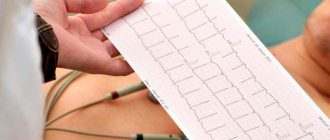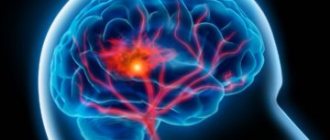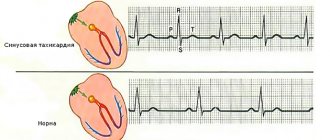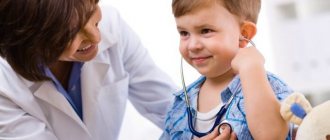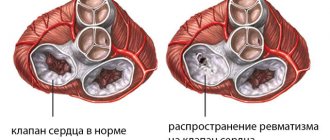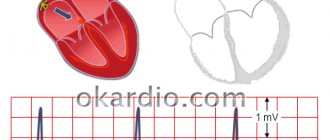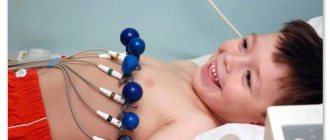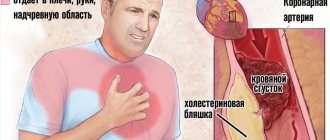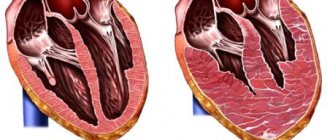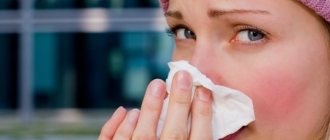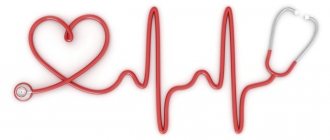The normal heart rate (according to WHO) is recognized as an interval from 60 to 89 beats per minute or a little more. Anything higher is tachycardia (usually from 100 beats per minute), lower is bradycardia. Both conditions are types of arrhythmia.
Sinus tachycardia of the heart is an increase in the frequency of contractions of the organ to 100 beats per minute or higher with the correct rhythm.
The term “sinus” indicates the etiology of the process. That is, the pathogenic change is localized in the natural driver - the sinus node. This is taken into account both when determining the form of the pathology and when selecting therapeutic tactics.
According to statistics (according to European data), sinus or sinusoidal tachycardia occurs in 15% of patients, many do not notice it due to the low intensity of the manifestations.
Only in 40% of clinical situations the process has pathological causes. The remaining 60% is a temporary phenomenon associated with physiology (idiopathic tachycardia). Most of the patients, according to American sources, are in the northern regions (including Russia, China, Scandinavian countries).
Forms of the disease and mechanism of development
Types of pathological process are distinguished based on heart rate.
Based on this criterion, three main varieties are called:
- Weakly expressed. Heart rate does not exceed 110 beats per minute.
- Moderate tachycardia. Frequency more than 130 beats. per minute
- Expressed. From 131 beats per minute.
Other classifications do not have much clinical significance. Sinus tachycardia can be divided into primary, which does not depend on other factors; it develops on its own, and secondary (caused by one or another disease, cardiac or extracardiac (usually) origin).
The mechanism of the problem is always the same. A special cluster of sensory cells or the so-called sinus node is responsible for the normal rhythm. It generates electrical impulses.
Theoretically, the heart can work autonomously for a long time. This is proven by the vegetative existence of patients diagnosed with brain death, but with a intact brainstem, responsible for maintaining the activity of the heart in principle.
From the sinus node, the impulse is transmitted through the bundles of His to other structures, and so on throughout the entire muscular organ until complete contraction occurs. The cycle continues constantly. The moment of impact is systole, the moment of relaxation is diastole. This allows the heart to work uninterruptedly for decades.
As a result of conduction disturbances in tissues or pathological or natural excitation of the sinus node, the frequency of contractions accelerates, sometimes to significant levels.
Etiology
The correct heart rhythm directly depends on how evenly impulses arise in the sinus node and are carried through the fiber system. The sinus node is a collection of nerve cells that are localized in the atrium.
Normally, the optimal values for sinus rhythm are the number of contractions, which range from sixty to ninety beats per minute. It follows from this that sinus tachycardia is nothing more than an increase in heart rate over 90 times per minute. It is worth noting that in children, such a disorder is diagnosed if the heart rate increases by more than 10% of the norm characteristic of a particular age.
This pathology occurs in any age category, in the vast majority of cases in healthy people, as well as among those diagnosed with heart disease. Given that the disease develops due to a large number of factors, they are usually divided into several groups - pathological and not related to the course of a particular disease.
The first category of causes of sinus tachycardia is also divided into cardiac and extracardiac. Thus, the provocateurs of this type of arrhythmia are:
- heart failure in acute or chronic form;
- dysfunction of the left ventricle of the heart;
- severe angina;
- myocarditis of any nature;
- myocardial infarction;
- the person has cardiomyopathy or cardiosclerosis;
- congenital or acquired heart defects;
- bacterial endocarditis;
- pericarditis of exudative or adhesive nature;
- primary disruption of the normal functioning of the cerebral cortex or subcortical nodes;
- neuroses and psychoses;
- cardiopsychoneurosis;
- pathologies of the endocrine system;
- anemia and sepsis;
- tuberculosis and pneumonia.
Physiological predisposing sources of the formation of sinus tachycardia of the heart are presented:
- excessive physical exertion - the permissible values can be no more than 160 beats per minute, the rest, higher indicators, belong to this type of arrhythmia. It is worth noting that the only exception is professional athletes - heart rate can reach 240 beats per minute - only in such cases there is no need for emergency care;
- prolonged exposure to stressful situations or one-time severe nervous strain;
- addiction to bad habits;
- irrational use of medications, for example, glucocorticoids, antidepressants, calcium antagonists, diuretics, substances containing caffeine, as well as medications aimed at treating bronchial asthma.
In addition, it should be noted that an increase in heart rate can be affected by an increase in body temperature. Each increase in the thermometer value by one division leads to the fact that the heart rate in a child increases by about 15 beats per minute, and in an adult - by 9.
The causes of sinus tachycardia in women can be:
- the period of bearing a child - despite the fact that sinus tachycardia is a normal phenomenon in pregnant women, it can develop against the background of pathological causes, which is why the appearance of symptoms of the disease should be the impetus for seeking qualified help;
- the course of menstruation;
- hot flashes observed during menopause, as well as any other hormonal disorders.
Causes and development factors
As already noted, there are two types.
Physiological
Not associated with any diseases. Natural sinus tachycardia is distinguished by 3 points:
- It appears suddenly and stops just as quickly.
- Not accompanied by severe symptoms. Minimal symptoms, such as shortness of breath or sweating, are possible.
- Does not pose a risk to health or life.
Among the development factors:
- Intense physical activity. Usually has an inadequate character. Lack of body fitness, somatic diseases and other factors significantly limit the functional activity of the heart. In this case, the organ tries to compensate for at least part of the weakened blood circulation by increasing the frequency of contractions. For obvious reasons, this cannot end well. Cardiogenic shock, heart attack or stroke. The load needs to be dosed and increased gradually, preferably according to a proven scheme. For some diseases, such as hypertension, this is completely contraindicated.
- Excessive caffeine consumption that day or the day before. Adult patients with pathologies of the cardiovascular system cannot drink such drinks in principle. Others are allowed, but with restrictions. Sinus tachycardia in such a situation can be stopped with improvised means and vagal techniques.
- Stress, intense psycho-emotional stress. Gives a slight acceleration of cardiac activity due to a long-term increase in the concentration of stimulating hormones. Symptoms are minimal, but the patient feels a pounding in the chest, which is not normal.
- Jar of Hearts. Of a momentary nature. It can have different forms and features; this is a question of psychological, not medical, plan. The result is an avalanche-like increase in the amount of cortisol and adrenaline in the circulatory system. Hence the vegetative manifestations: fainting, palpitations, loss of orientation in space, also depersonalization and mental deviations of a transient type.
- Night terrors or nightmares. Causes a temporary increase in heart rate. They do not pose any danger to health or life. All manifestations pass in 2-3 minutes or even faster.
Sinus tachycardia, to some extent “correct”. Because the main pacemaker is excited. This is physiological, although it can be dangerous. It is much worse if the ventricles or atria are involved in the process. Such pathologies are much more difficult to diagnose and more difficult to treat.
Pathogenic factors
The following somatic problems are possible:
- Osteochondrosis and vertebrobasilar insufficiency. They directly affect the quality of cerebral circulation and the nutrition of cerebral structures, partly responsible for stimulating cardiac activity. Symptoms in the early stages are vague, the full clinical picture includes pain in the neck, head, fainting, vertigo, paresthesia (numbness in fingers).
- Other neurological conditions. From brain tumors to epilepsy. Diagnostics under the supervision of a specialized specialist using EEG, CT, MRI, status assessment.
- Blood pressure surges. Also persistent increases or decreases in the tonometer reading. Both are dangerous. Hypotonic patients should not hope for a miracle. The manifestations are, surprisingly, almost identical. Symptoms include headache, vertigo, nausea, vomiting, weakness, lethargy, drowsiness, fainting, dark vision and tinnitus.
- Insufficient nutrition of the body as a result of anorexia, malignant processes in the terminal phase, problems with the gastrointestinal tract. Cachexia does not manifest itself immediately, but after some time. Restoring adequate tissue trophism is the goal of treatment. And here problems arise: the stomach is able to accept food, but the walls are atrophied, and rupture is possible. Such patients are fed with caution, in strictly controlled quantities.
- Heart defects, congenital and acquired. There are a lot of options among them, many do not make themselves felt at all, the only symptom is stopping work. Diagnosis after the fact on the pathologist's table.
- Endocarditis, myocarditis. Inflammatory lesions of cardiac structures. Usually infectious, less often autoimmune in origin. Left untreated, they lead to destruction of the myocardium or atria. The only way to recover is complex and expensive prosthetics.
- Anemic processes. Resulting from a lack of vitamin B12 (megaloblastic type) or iron (iron deficiency type). Such phenomena themselves are the result of insufficient nutrition or regular bleeding (the menstrual cycle does not count).
- COPD, pulmonary artery pathology. They usually go hand in hand. Therefore, chronic smokers better be on their guard. Rapid but silent changes in the structures of the respiratory tract are possible. They can be detected in the later stages. If you have shortness of breath after minor physical activity, problems with cardiac activity, pale skin, cold fingers or toes, it is better to consult a pulmonologist. The next step is giving up the bad habit.
- Metabolic problems. Externally they manifest themselves as obesity of varying severity. Nutrition is subject to correction. Treatment is also required. Usually the etiology of the process is endocrine or mixed.
- Infectious phenomena. Even a cold is enough to increase the rate of cardiac activity. Such tachycardia is persistent in itself and is difficult to stop even with drugs, not to mention “grandmother’s” recipes and vagal techniques. Detoxification measures are necessary, that is, the fight against the root cause.
- Hypercortisolism, hyperthyroidism. Excess of adrenal and thyroid hormones, respectively.
Finally, there are regulated, controllable factors: smoking, alcoholism, drug use. It is highly not recommended to take antihypertensive drugs, diuretics, and tonics uncontrollably.
What is sinus tachycardia of the heart
Not every person will be able to determine why the heart rate increases, attributing it to excitement or fatigue. To avoid complications, you should know what sinus tachycardia is: an increase in heart rate (heart rate) of up to 100 beats or more. This symptom is a sign of tachycardia, which is a form of supraventricular tachyarrhythmia. In international medicine, the disease has the abbreviation ICD-10. Doctors distinguish two types - physiological and pathological.
- The first type of disease can be either congenital, which often occurs in girls of any age and teenage boys, or acquired during life. Acquired tachycardia manifests itself during active physical activity, and after it, in a state of strong excitement and stress. This reaction of the heart is a normal response of our body; it is temporary.
- Pathological tachycardia is divided into adequate and inadequate. The latter is characterized by a persistent, symptomatic increase in heart rate of more than one hundred beats per minute when a person is awake and at rest or during light physical activity. The diagnosis is correct if attacks of rapid heartbeat continue for three months without an obvious reason. Adequate sinus tachycardia (ST) is an increase in heart rate with:
- arterial hypotension;
- anemia;
- hypoxemia;
- pheochromocytoma;
- thyrotoxicosis.
Heart rate and rhythm
Changes in heart rate and heartbeat rhythm are considered obvious symptoms of an attack of tachycardia. Heart rate is an important sign of sinus node problems. At the same time, moderate tachycardia is a typical reaction of the body to loads or stress. A characteristic feature of this disease is the preservation of the heart rhythm, and if this is also disturbed, then this is already an arrhythmia. You should have an electrocardiogram if you:
- feeling of “fluttering” of the heart, rapid heartbeat;
- weakness and dizziness;
- general weakness, decreased performance;
- increased heart rate when changing from horizontal to vertical body position;
- chest pain.
Only a doctor should decipher the cardiogram, after which he writes a conclusion and prescribes appropriate treatment. If you want to understand what your ECG showed, then you should understand some terminology. The following indicators are important for making a correct diagnosis and prescribing further treatment for palpitations:
- EOS (electrical axis of the heart) indicates the position of the heart during cardiography. It can be normal, with a deviation to the right or left, horizontal, vertical.
- Heart rate. A heart rate over 90 beats per minute is considered a deviation.
- When the heart is stimulated by secondary sources of electrical cardiac potentials, it is indicated that this is a non-sinus rhythm. The indicator indicates heart disease.
- Hypertrophy of the right or left ventricle. Indicates an increase in the size of the heart ventricle or thickening of its wall.
- Atrial fibrillation. It speaks of heart rhythm disturbances, which is typical for people over 60. There is a possibility of developing heart failure and brain stroke.
- Paroxysm of atrial fibrillation. This is a sharp attack of atrial fibrillation found on the cardiogram, which requires immediate treatment.
- Extrasystole is an abnormal impulse on the cardiogram due to an extraordinary contraction of the heart muscle. There is atrial, ventricular, atrioventricular extrasystole.
Causes
- Hypovolemia.
- Hypoxia.
- Adrenergic drugs.
- Hypotension.
- Increased temperature due to inflammation or systemic infection.
- Thyrotoxicosis.
- Cardiomyopathy with concomitant dysfunction of the left ventricle.
- Respiratory failure.
- Fever.
- Acute vascular insufficiency.
- Hyperthyroidism.
- Use of a number of medications (aminophylline, slow calcium channel blockers, caffeine).
Is tachycardia dangerous?
Sinusoidal tachycardia is improper work of the heart muscle for wear and tear. Such a load can provoke the development of heart failure, other rhythm disturbances, and a decrease in blood pressure. The pathology disrupts the blood supply to the heart, which increases the likelihood of developing coronary artery disease and heart attack. Of particular danger is the possibility of thromboembolism of cerebral vessels, pulmonary artery, and against the background of myocardial infarction - ventricular fibrillation, which leads to sudden death. Therefore, people with attacks of tachycardia are not accepted into the army.
Symptoms
The sinus form of tachycardia can flow continuously or paroxysmally (paroxysmal form). In the first case, the patient quickly ceases to feel the problem as the body adapts. It is important to catch manifestations in a timely manner.
Among them:
- Panic attack. Caused by impaired blood flow in the brain. Accompanied by a strong feeling of fear and a desire to hide. They are fraught with suicidal attempts, but such signs in themselves do not pose a danger. Everything passes without a trace after the end of the acute period.
- Feeling of heart beating in chest. An extremely uncomfortable moment that significantly reduces the quality of life.
- Aching or pressing pain behind the sternum. May indicate myocardial infarction. If such a sign appears, especially if it lasts for more than 15-20 minutes, you should call an ambulance.
- Dizziness for no apparent reason.
- Weakness and drowsiness.
Objectively, one can also detect additional arrhythmia (unequal intervals between heartbeats), a drop in blood pressure by 20-30 mmHg from normal.
First aid for an attack
If sinus tachycardia has already taken root in the body, that is, it shows resistance (immunity to treatment), the recommendations presented are of little use. In other situations, it makes sense to try to stop the episode on your own.
It is necessary to strictly adhere to the algorithm:
- Measure blood pressure and heart rate. This is important for subsequent assessment of the effectiveness of therapy.
- Take a beta blocker tablet (Anaprilin or Carvedilol). Strictly one, do not exceed the dosage.
- Drink tea with St. John's wort, chamomile, valerian, motherwort and peppermint. Eat 2 tablespoons of lemon with honey.
- Take a horizontal position and move less.
- Apply vagal techniques: press on the eyeballs with little force for 10-15 seconds, and continue this way for 5 minutes. Breathe slowly (5 seconds for each element of the cycle), repeat for 10 minutes.
Reassess blood pressure and heart rate levels. If there is no effect or if the process worsens, call an ambulance. Experiments on the body are not recommended.
Diagnostics
It is carried out under the supervision of a cardiologist in an inpatient or outpatient setting. An endocrinologist and other specialists are involved as needed.
The following list can be presented as a survey scheme:
- Oral assessment of the patient's complaints with recording of symptoms in writing.
- Anamnesis collection. Standard clarification of the probable causes of the pathological process. Everything needs to be told. The doctor will separate the wheat from the chaff.
- Measurement of blood pressure, heart rate.
- Electrocardiography. In the absence of tachycardia at the moment, an ECG is taken with stress tests (the most gentle is bicycle ergometry).
- Echocardiography. Ultrasound methods for assessing the condition of muscle organ structures.
- With hypertension and pulmonary problems, the picture becomes obvious even to an inexperienced diagnostician.
- Angiography.
- CT.
- General blood test, hormones, biochemical.
Other studies are prescribed as necessary.
Therapeutic tactics
Treatment of sinus tachycardia is varied; there are several ways to eliminate the condition.
Drug effects
Drugs from a number of pharmaceutical groups are used:
- Adrenergic blockers. Carvedilol, Anaprilin. Prevents increased blood pressure and stimulation of the sinus node.
- Antiarrhythmic drugs: Amiodarone and analogues.
- Calcium channel blockers. Diltiazem, Verapamil.
- Cardiac glycosides: Digoxin and lily of the valley tincture.
- Sedatives and tranquilizers: motherwort, valerial, Diazepam and others.
- Magnesium-calcium complexes (Asparkam, Magnelis).
Systematic application is important. Either all groups of drugs or several are used. The final list of drugs, their combination and dosage is selected by the doctor.
Surgery
- For congenital and acquired defects, their elimination.
- Tissue ruptures - normalization of anatomical integrity.
- Severe sinus tachycardia is stopped by implantation of a pacemaker or artificial pacemaker.
- Destruction of the atria - prosthetics.
The techniques are used in extreme cases.
Folk recipes
- Anise, calendula and valerian. 50 g of each component, 300 ml of water. Drink 2 tsp. 3 times a day for a month.
- Motherwort, peppermint and St. John's wort. 100 g of crushed raw materials, 0.5 l of boiling water. Take a glass or two per day.
- Melissa. Decoction (200 grams per 500 ml of water). Drink half a glass per day.
- Lemon with honey and dried apricots. In any quantity.
The use of these recipes is not the main treatment, but an aid to it, the main goal is symptomatic assistance.
Lifestyle change
- Rejection of bad habits.
- 8 hour sleep.
- 2 hours of physical activity per day (walking).
- Correct drinking regime (1.8-2 liters per day).
- Refusal of large amounts of salt (no more than 7 grams per day).
Diet correction:
Can:
- Cereals, porridge (except for semolina, it is only in moderation).
- Fermented milk products (minimal fat).
- Oils, including butter.
- Boiled eggs.
- Dried fruits, nuts, honey.
- Coarse bread.
- Lean meat and soups based on it.
- Berries.
- Fish.
It is forbidden:
- Roast.
- Smoked.
- Semi-finished products, canned food.
- Salt more than 7 grams per day.
- Fat meat.
- Sweets.
- Chocolate.
- Tea.
- Coffee.
- Energy.
- Fast food.
Treatment tables No. 3 and No. 10 are recommended, with minor menu adjustments in both directions. Better under the supervision of a nutritionist. It is important not to eat at night and avoid a large dinner. Eat small meals whenever possible.
Treatment
The main condition is not to worry. Otherwise, the situation may get worse. To eliminate symptoms, many patients have to:
- exclude alcoholic drinks and tobacco;
- devote more time to rest, stop physical activity;
- follow the recommendations of proper nutrition;
- walk more in the fresh air.
Important:
self-treatment does not guarantee that attacks of tachycardia will not return. It is recommended to seek help from specialists who will prescribe the correct therapy (if an attack does occur, you need to know about the rules of first aid before the ambulance arrives, which we wrote about in detail here).
Use of folk remedies
If you are concerned about stressful conditions, or nervous tension often occurs, it is recommended to take sedative tinctures, herbal teas, herbal infusions based on lemon balm, mint and hawthorn. These drugs are harmless, even teenagers are allowed to take them.
Warm baths and massages have proven themselves to be excellent. Honey mixed with beet juice helps improve blood circulation and dilate blood vessels. It is allowed to drink decoctions of viburnum, valerian root, berries and hawthorn inflorescences.
Prevention
- Quitting smoking and alcohol.
- Normalization of diet.
- Drinking regimen: 2 liters per day.
- Limiting salt.
- Physical activity (2 hours of absenteeism per day).
- Full sleep.
- Avoiding stress and overload.
Sinus tachycardia means an increase in heart rate above 100 beats per minute as a result of impaired conduction of the sinus node, or its natural excitation.
The danger is minimal, but there are always risks. Therefore, you should not turn a blind eye to the problem. Treatment by a cardiologist is the most correct solution.
Sinus tachycardia in children
This condition is considered today to be a fairly common and characteristic manifestation of accelerated sinus rhythm in children and is manifested by an increase in the number of heart contractions, but no special deviations from its normal functioning are observed. In children, signs of increased heart rate can develop when overstrain of any nature occurs, both emotional and physical. This is why the sinoatrial node (SU) automatically enlarges. In newborns, this diagnosis is made if the heart rate exceeds one hundred and sixty beats per minute. Sinus tachycardia is observed in almost 40% of children.
The main reasons for the development of this condition in newly born children are anemia, acidosis, hypoglycemia and physiological reasons in the form of a medical examination, anxiety, swaddling, painful attacks, overheating, as well as pathological processes in the cardiovascular system associated with heart failure . This mild form of this condition generally goes away on its own by the first year of a child’s life, without the use of any medical interventions.
Suspicions of changes in sinus rhythm in children may be a heart rate from one hundred beats per minute to one hundred and sixty
However, such fluctuations are not taken into account if they arose at the time of the child’s feverish state, after intense physical exercise, long and strenuous walks, while in a room where it is difficult to breathe as a result of the fact that it may be stuffy, and also after suffered stress. In addition, if the heart rate returns to normal within five minutes, and it is not accompanied by fainting, shortness of breath, or heart pain, then the child is considered completely healthy.
Sinus tachycardia in adolescents very often develops as a consequence of endocrine changes, anemia, stress, physical and emotional fatigue. As a rule, such causative factors of the disease in children and adolescents must be urgently eliminated in order to avoid pathological tachycardia. You also need to understand that this condition in children can be very dangerous and in the future become the cause of vegetative-vascular dystonia of the hypertensive type, as well as lead to cardiac pathology such as heart failure.
Thus, it is very important to carefully monitor such children when symptoms of this pathology occur to prevent its worsening. Although it is also necessary to take into account that this condition may be a physiological phenomenon in a child caused by an immature cardiovascular system
But, nevertheless, when children have an attack of sinus tachycardia, it is necessary to create access to fresh air, freeing the child’s neck from constricting clothing, putting something cooling on the forehead and providing the baby with everything necessary to calm him down. Then call medical help and conduct a thorough examination to find out the reasons for the development of rapid heart rate.
